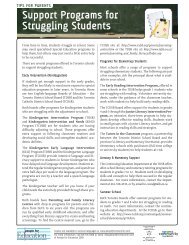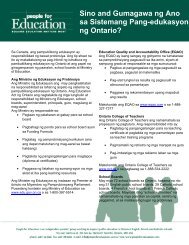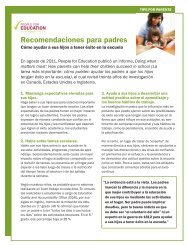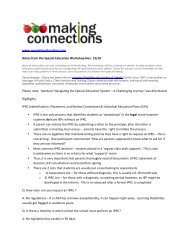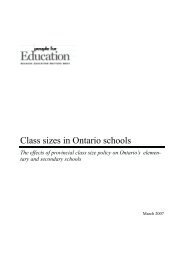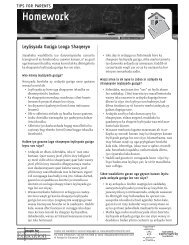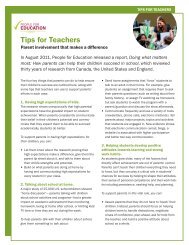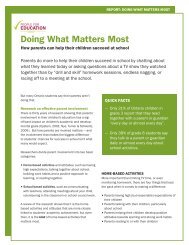Our Children Our Future Our Vision - People for Education
Our Children Our Future Our Vision - People for Education
Our Children Our Future Our Vision - People for Education
You also want an ePaper? Increase the reach of your titles
YUMPU automatically turns print PDFs into web optimized ePapers that Google loves.
<strong>Our</strong> <strong>Children</strong>, <strong>Our</strong> <strong>Future</strong>, <strong>Our</strong> <strong>Vision</strong><br />
COMMENTS: There were a total of 47 comments in this category, which were coded under the<br />
major themes of Language & Culture (12), Funding (10), Curriculum (9), Lifelong Learning (3), and<br />
General Commentary (13).<br />
Comments that were categorized under Language and Culture (12) noted that the early learning<br />
programs should be language immersion (6), with full cultural teachings and activities. Funding<br />
(10) was also noted as a concern, with all respondents citing insufficient funding <strong>for</strong> early learning<br />
programs. Curriculum (9) <strong>for</strong> early learning programming was also noted as being important, and<br />
was tied to the culture of the First Nation community (these comments link closely to the comments<br />
on Language and Culture).<br />
3. K – 12<br />
Q1: The curriculum, textbooks, and resources used in First Nation schools are comparable to those<br />
found in provincial schools. This question was concerned with the instructional resources available<br />
in First Nations schools, and 65.5% of the respondents were in total / some disagreement with<br />
the statement that the resources were comparable to those found in the provincial school system.<br />
Only 8.3% of the respondents felt that the textbooks and resources in First Nation schools were at<br />
least comparable to the provincial system, while 26% had no opinion either way.<br />
Q2: Tuition agreements between local public school boards and First Nation communities provide<br />
an opportunity <strong>for</strong> First Nation communities to pursue a measure of First Nation control of First<br />
Nation education. For those First Nation communities that have tuition / education service agreements<br />
with their local provincial school board, 47.9% were in total / some disagreement that Tuition<br />
Agreements gave their First Nation a measure of control, with only 25.6% were in full / overwhelmingly<br />
in agreement with the statement, and 26.5% had no opinion either way.<br />
Q3: Capacity building and restructuring are equally as important to support elementary and secondary<br />
education as the infusion of ‘new money’. Respondents were in full / overwhelmingly in<br />
agreement that capacity building and restructuring within the First Nation school system was as<br />
important as funding (the infusion of new money), with 69.3% indicating so, with 17.7% having no<br />
opinion either way.<br />
Q4: Band operated elementary schools prepare First Nation students adequately to transition<br />
into provincially funded secondary schools. This question is concerned with transferability from<br />
First Nation schools to provincial schools, and may be an indicator of quality as perceived by the<br />
respondents. Of the respondents, 66% indicated that they were in total / some disagreement with<br />
the statement, with only 14% were in full / overwhelmingly in agreement that the band operated<br />
schools prepare First Nations students to transition into provincial schools, and 20% responding<br />
that they had no opinion either way.<br />
65 Chiefs of Ontario




